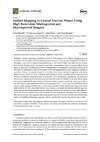Please use this identifier to cite or link to this item:
https://accedacris.ulpgc.es/jspui/handle/10553/42010
| Title: | Seabed mapping in coastal shallow waters using high resolution multispectral and hyperspectral imagery | Authors: | Marcello, Javier Eugenio, Francisco Martin, Javier Marqués, Ferran |
UNESCO Clasification: | 220921 Espectroscopia | Keywords: | Benthic mapping Seagrass Airborne hypespectral imagery Worldview-2 Atmospheric correction, et al |
Issue Date: | 2018 | Publisher: | 2072-4292 | Project: | Procesado Avanzado de Datos de Teledetección Para la Monitorización y Gestión Sostenible de Recursos Marinos y Terrestres en Ecosistemas Vulnerables. | Journal: | Remote Sensing | Abstract: | Coastal ecosystems experience multiple anthropogenic and climate change pressures. To monitor the variability of the benthic habitats in shallow waters, the implementation of effective strategies is required to support coastal planning. In this context, high-resolution remote sensing data can be of fundamental importance to generate precise seabed maps in coastal shallow water areas. In this work, satellite and airborne multispectral and hyperspectral imagery were used to map benthic habitats in a complex ecosystem. In it, submerged green aquatic vegetation meadows have low density, are located at depths up to 20 m, and the sea surface is regularly affected by persistent local winds. A robust mapping methodology has been identified after a comprehensive analysis of different corrections, feature extraction, and classification approaches. In particular, atmospheric, sunglint, and water column corrections were tested. In addition, to increase the mapping accuracy, we assessed the use of derived information from rotation transforms, texture parameters, and abundance maps produced by linear unmixing algorithms. Finally, maximum likelihood (ML), spectral angle mapper (SAM), and support vector machine (SVM) classification algorithms were considered at the pixel and object levels. In summary, a complete processing methodology was implemented, and results demonstrate the better performance of SVM but the higher robustness of ML to the nature of information and the number of bands considered. Hyperspectral data increases the overall accuracy with respect to the multispectral bands (4.7% for ML and 9.5% for SVM) but the inclusion of additional features, in general, did not significantly improve the seabed map quality. | URI: | https://accedacris.ulpgc.es/handle/10553/42010 | ISSN: | 2072-4292 | DOI: | 10.3390/rs10081208 | Source: | Remote Sensing [ISSN 2072-4292], v. 10(8), 1208 |
| Appears in Collections: | Artículos |
Items in accedaCRIS are protected by copyright, with all rights reserved, unless otherwise indicated.
